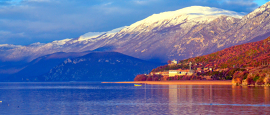Albania Weather, climate and geography
Weather & climate
Albania enjoys a Mediterranean climate, characterised by hot, dry summers and mild, wet winters. The country's diverse geography, ranging from coastal areas to mountainous regions, creates varying weather conditions across different parts of Albania.
Spring (March to May)
Spring is one of the best times to visit Albania. Temperatures range from 12°C to 25°C (54°F to 77°F), and the countryside comes alive with lush greenery and wildflowers. Rainfall decreases as the season progresses, and it's an ideal time for hiking or exploring historical sites without the summer crowds.
Summer (June to August)
Summers in Albania are hot, especially along the coast, where temperatures average between 25°C and 35°C (77°F to 95°F). Inland regions, particularly in the mountains, are cooler and offer a pleasant escape from the heat. This is peak travel season, with visitors flocking to the Albanian Riviera for its turquoise waters and lively beaches.
Autumn (September to November)
Autumn brings milder temperatures, ranging from 15°C to 28°C (59°F to 82°F), and a quieter, more relaxed atmosphere. It's an excellent time to explore vineyards, enjoy harvest festivals, or take scenic drives through the countryside as the leaves change colour. Rainfall increases slightly in late autumn.
Winter (December to February)
Winters in Albania are mild along the coast, with temperatures averaging between 5°C and 15°C (41°F to 59°F). In the mountainous regions, such as the Albanian Alps, temperatures drop significantly, and snowfall is common, making these areas appealing for winter sports enthusiasts. Yes, you can ski in Albania, but the infrastructure is still developing compared to other European countries. Rainfall is more frequent during this season, particularly in the lowlands.
When visiting Albania, clothing choices should align with the season and planned activities. In summer, lightweight and breathable clothing is ideal, along with comfortable shoes for exploring cities or hiking trails. A swimsuit is essential for coastal trips, while a light jacket may be handy for cooler evenings. In winter, warmer layers, waterproof outerwear, and sturdy footwear are recommended, especially for mountainous regions where snow is common. Modest clothing is appreciated when visiting religious sites or rural areas, so packing a scarf or shawl for women and avoiding overly revealing attire is a good idea.
Geography
Albania is a small yet geographically diverse country in southeastern Europe, nestled along the Adriatic and Ionian Seas. It shares borders with four countries: Montenegro to the northwest, Kosovo to the northeast, North Macedonia to the east, and Greece to the south.
Its landscape is dominated by rugged mountains, such as the Albanian Alps in the north and the Pindus range in the south, making up about 70% of its terrain. The coastline stretches over 450 km (280 miles), featuring pristine beaches, dramatic cliffs, and the famed Albanian Riviera. Fertile plains, particularly around the cities of Fier and Shkodër, provide rich agricultural land, while large lakes such as Lake Shkodër, Lake Ohrid, and Lake Prespa add to the country's natural beauty. The highest point is Mount Korab, towering at 2,764 metres, located along the border with North Macedonia.
Do you have any Feedback about this page?
© 2025 Columbus Travel Media Ltd. All rights reserved. No part of this site may be reproduced without our written permission, click here for information on Columbus Content Solutions.




 You know where
You know where